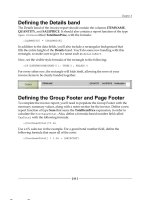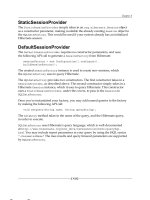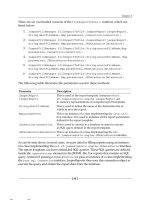UML for java developers
Bạn đang xem bản rút gọn của tài liệu. Xem và tải ngay bản đầy đủ của tài liệu tại đây (311.47 KB, 16 trang )
© Jason Gorman 2005. All rights reserved.
1
UML for Java Developers
Class Diagrams
© Jason Gorman 2005. All rights reserved.
2
"I am currently working on a
team which is [in] the process
of adopting RUP and UML
standards and practices. After
one of our design sessions, I
needed to lookup some
information and came across
your site. Absolutely great!
Most [of] the information I've
had questions about is
contained within your tutorials
and then some."
"Really great site I have been
trying to grasp UML since the
day I saw Visual Modeler. I
knew a few things but there
were gaps. Thanks to your site
they have shrunk
considerably."
"I went on a UML training
course three months ago, and
came out with a big folder full
of hand-outs and no real
understanding of UML and how
to use it on my project. I spent
a day reading the UML for
.NET tutorials and it was a
much easier way to learn.
'Here's the diagram. Now
here's the code.' Simple."
www.parlezuml.com/training.htm
advertisement
UML for Java Developers (5 Days)
Since Autumn 2003, over 100,000 Java and .NET developers have
learned the Unified Modeling Language from Parlez UML
() , making it one of the most popular
UML training resources on the Internet.
UML for Java Developers is designed to accelerate the learning
process by explaining UML in a language Java developers can
understand – Java!
From Requirements to a Working System
Many UML courses focus on analysis and high-level design, falling
short of explaining how you get from there to a w orking system. UML
for Java Developers takes you all the w ay from system
requirements to the finished code because that, after all, is w hy we
model in the first place.
Learning By Doing
UML modeling is a practical skill, like driving a car or flying a plane.
Just as w e don’t learn to drive just by looking at Pow erPoint
presentations, you cannot properly learn UML w ithout getting plenty
of practice at it.
Your skills w ill be developed by designing and building a w orking
piece of software, giving you a genuine understanding of how UML
can be applied throughout the development lifecycle.
© Jason Gorman 2005. All rights reserved.
3
www.parlezuml.com/training.htm
Class Diagrams
Model types of objects and
the relationships between
them.
Sequence Diagrams
Model how objects interact
to achieve functional goals
Activity Diagrams
Model the flow of use cases
and single and multi-threaded
code
Use Case Diagrams
Model the users of the system
and the goals they can achieve
by using it
Object Diagrams & Filmstrips
Model snapshots of the running
system and show how actions
change object state
Implementation Diagrams
Model the physical components of a
system and their deployment
architecture
Packages &
Model Management
Organise your logical and physical
models with packages
Object Constraint Language
Model business rules and create
unambiguous specifications
Statechart Diagrams
Model the behaviour of objects
and event-driven applications
User Experience Modeling
Design user-centred systems with
UML
Design Principles
Create well-designed software
that’s easier to change and
reuse
Design Patterns
Apply proven solutions to common
OO design problems
UML for Java Developers covers the most useful aspects of the
UML standard, applying each notation w ithin the context of an
iterative, object oriented development process
© Jason Gorman 2005. All rights reserved.
4
Classes
Account
class Account
{
}
class Account
{
}
© Jason Gorman 2005. All rights reserved.
5
Attributes
Account
class Account
{
private float balance = 0;
private float limit;
}
class Account
{
private float balance = 0;
private float limit;
}
- balance : Single = 0
- limit : Single
[visibility] [/] attribute_name[multiplicity] [: type [= default_value]]
© Jason Gorman 2005. All rights reserved.
6
Operations
Account
class Account
{
private float balance = 0;
private float limit;
public void deposit(float amount)
{
balance = balance + amount;
}
public void withdraw(float amount)
{
balance = balance - amount;
}
}
class Account
{
private float balance = 0;
private float limit;
public void deposit(float amount)
{
balance = balance + amount;
}
public void withdraw(float amount)
{
balance = balance - amount;
}
}
- balance : Single = 0
- limit : Single
+ deposit(amount : Single)
+ withdraw(amount : Single)
[visibility] op_name([[in|out] parameter : type[, more params]])[: return_type]
© Jason Gorman 2005. All rights reserved.
7
Visibility
Account
- balance : float = 0
+ limit : float
# id : int
~ databaseId : int
+ deposit(amount : single)
-withdraw(amount : single)
# getAvailableFunds() : single
~ getDatabaseId() : int
+ = public
- = private
# = protected
~ = package
class Account
{
private float balance = 0;
public float limit;
protected int id;
int databaseId;
public void deposit(float amount)
{
balance = balance + amount;
}
private void withdraw(float amount)
{
balance = balance - amount;
}
protected int getId()
{
return id;
}
int getDatabaseId()
{
return databaseId;
}
}
class Account
{
private float balance = 0;
public float limit;
protected int id;
int databaseId;
public void deposit(float amount)
{
balance = balance + amount;
}
private void withdraw(float amount)
{
balance = balance - amount;
}
protected int getId()
{
return id;
}
int getDatabaseId()
{
return databaseId;
}
}
© Jason Gorman 2005. All rights reserved.
8
Class & Instance
Scope
Person
- numberOfPeople : int
- name : string
+ createPerson(name : string) : Person
+ getName() : string
+ getNumberOfPeople() : int
- Person(name : string)
class Person
{
private static int numberOfPeople = 0;
private String name;
private Person(string name)
{
this.name = name;
numberOfPeople++;
}
public static Person createPerson(string name)
{
return new Person(name);
}
public string getName()
{
return this.name;
}
public static int getNumberOfPeople()
{
return numberOfPeople;
}
}
class Person
{
private static int numberOfPeople = 0;
private String name;
private Person(string name)
{
this.name = name;
numberOfPeople++;
}
public static Person createPerson(string name)
{
return new Person(name);
}
public string getName()
{
return this.name;
}
public static int getNumberOfPeople()
{
return numberOfPeople;
}
}
int noOfPeople = Person.getNumberOfPeople();
Person p = Person.createPerson("Jason Gorman");
int noOfPeople = Person.getNumberOfPeople();
Person p = Person.createPerson("Jason Gorman");
© Jason Gorman 2005. All rights reserved.
9
Associations
A B
1
b
multiplicity
role name
A
b : B
Equivalent to
class A
{
public B b = new B();
}
class B
{
}
class A
{
public B b = new B();
}
class B
{
}
A a = new A();
B b = a.b;
A a = new A();
B b = a.b;
1
© Jason Gorman 2005. All rights reserved.
10
Bi-directional Associations
A
b : B
Equivalent to
class A
{
public B b;
public A()
{
b = new B(this);
}
}
class B
{
public A a;
public B(A a)
{
this.a = a;
}
}
class A
{
public B b;
public A()
{
b = new B(this);
}
}
class B
{
public A a;
public B(A a)
{
this.a = a;
}
}
A a = new A();
B b = a.b;
A a1 = b.a;
assert a == a1;
A a = new A();
B b = a.b;
A a1 = b.a;
assert a == a1;
B
a : A
A B
1
b
multiplicity
role name
a
1
© Jason Gorman 2005. All rights reserved.
11
Association names & role
defaults
Person Address
Lives at
Default role name = address
Default multiplicity = 1
class Person
{
// association: Lives at
public Address address;
public Person(Address address)
{
this.address = address;
}
}
class Person
{
// association: Lives at
public Address address;
public Person(Address address)
{
this.address = address;
}
}
© Jason Gorman 2005. All rights reserved.
12
Multiplicity & Collections
Customer Account
1 *
accounts
class Customer
{
// accounts[1 *] : Account
ArrayList accounts = new ArrayList();
public Customer()
{
Account defaultAccount = new Account();
accounts.add(defaultAccount);
}
}
class Customer
{
// accounts[1 *] : Account
ArrayList accounts = new ArrayList();
public Customer()
{
Account defaultAccount = new Account();
accounts.add(defaultAccount);
}
}
Customer
accounts[1 *] : Account
Equivalent to
1 2
© Jason Gorman 2005. All rights reserved.
13
Aggregation & Composition
Computer HardwareDevice
1 *
Aggregation – is made up of objects that can be shared or exchanged
ShoppingBasket OrderItem
1 *
Composition – is composed of objects that cannot be shared or exchanged
and live only as long as the composite object
0 1
1
© Jason Gorman 2005. All rights reserved.
14
Generalization
Person
Employee
class Person
{
}
class Employee extends Person
{
}
class Person
{
}
class Employee extends Person
{
}
© Jason Gorman 2005. All rights reserved.
15
Realization
<<interface>>
Person
Employee Employee
Person
OR
interface Person
{
}
class Employee implements Person
{
}
interface Person
{
}
class Employee implements Person
{
}
© Jason Gorman 2005. All rights reserved.
16
www.parlezuml.com









